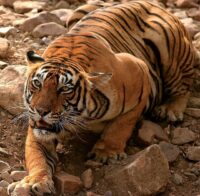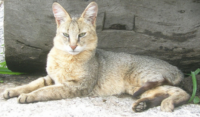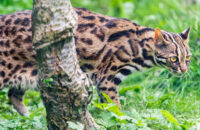Where To Track The Big Cats In India

India is known for diversified wildcats that are spread in every corner of the sub continent. They are seen in almost every forest type, be it tropical rain forests, lowland forests, desert forests or even in high altitude regions. The country is home to around 40% of wildcats in the world. This blog has the details of most popular big cats in India-
The Asiatic Lion:
COMMON NAME: Asiatic Lion
SCIENTIFIC NAME: Panthera leo persica
TYPE: Mammals
DIET: Carnivore
GROUP NAME: Pride
AVERAGE LIFE SPAN IN THE WILD: 16 to 18 years
WEIGHT: 300 to 500 pounds
The pride of Gujarat, Asiatic lion is now restricted to be seen in Gir National Park. Historically, it was seen inhabited in Western part of Asia and the Middle East and prowled towards northern India. These big cats are in the red list of endangered species.
Lions are the only cats that prefer to leave in groups. The groups are popularly known as prides will have up to 3 males and around a dozen females along with their cubs. Young males eventually leave and establish their own pride as they grow.
Males defend their pride’s territory. They do it by marking the area with urine, warning intruders with roar and chasing them when they try to encroach. The female cats are the primary hunters. They unite to pounce on larger animals. Lions do not mind hunting alone, if there is a necessity. However, they do steal the kills from hyenas and wild dogs.
The only place in India where you can find Asiatic lions in India is in Gir National Park, Gujarat. Currently, there are over 600 lions (male and female together) in the forest, however, they are in the list of endangered species.

Royal Bengal Tiger:
COMMON NAME: Royal Bengal Tiger
SCIENTIFIC NAME: Panthera Tigris
TYPE: Mammals
DIET: Carnivore
GROUP NAME: Pride
AVERAGE LIFE SPAN IN THE WILD: 8 to 10 years
WEIGHT: 386 to 573 pounds by male and 220 to 350 pounds by female
Considered as the national animal of India, the royal Bengal Tiger is one of the reasons why the Indian forests are explored by the entire world. These big cats are spread across the subcontinent, however, sighting them is a challenge for wildlife enthusiasts.
There was a time when the tigers were about to extinct with less than 1500 all over the country in the last decade. However, with multiple campaign awareness and right conservations, there are close to 3000 tigers now considering all the tiger reserves and zoos.
A group of tigers is either called streak’ or an ‘ambush. Unlike lions, tigers are usually seen in solitude. They create a zone of their own in the jungle. They hardly move across the zone and do not spare any other species who dare to enter their zone. The female tiger or tigress can go to any level to defend her cubs from other zone tigers. One the cub reaches a certain age, it will time for the lad to create a zone for his/her own. The forests in India that are open for wildlife explorations have them under core and buffer zones. The core zones being framed since a long time, the buffer zones are created based on the migration of these big cats either due to the quest of water or due to climate change or due to domination.
The Royal Bengal Tiger can be found in forest reserves all over the country. In south, the popular national parks include Kabini, Bandipur National Park, Nagarhole National Park, Bhadra National Park, Thekkady Wildlife sanctuary, Mudumalai National Park, Periyar Tiger reserve, Kali Tiger reserve and many smaller, less popular forest reserves.
In Central India, there are popular tiger reserves in Tadoba, Pench, Bandavgarh, Kanha, Jharna, Balharshah, Umred and so on. The northern part has tiger reserves in Ranthambore National Park, Sariska, Jim Corbett, Philibit, Hemis, Buxa, Sunderbans, Kaziranga and many more that are less established.

Leopard
COMMON NAME: Leopard
SCIENTIFIC NAME: Panthera Pardus
TYPE: Mammals
DIET: Carnivore
GROUP NAME: Leap
AVERAGE LIFE SPAN IN THE WILD: 12 to 17 years
WEIGHT: 26 – 90 kg
Widely seen in sub-Saharan Africa and rarely seen in western and central Asia, the leopards are a bigger version of Wildcat. Proud part of the panther family, with relatively short legs, long body, and large skull.
Leopards prefer being solitary. The strange fact being that they prefer socializing only while mating or raising its cub. The males and females prefer hunting solo rather than in group.
Leopards can be found in almost every established wildlife reserve all over the country. The popular national parks in the south include Kabini, Bandipur National Park, Nagarhole National Park, Bhadra National Park, Thekkady Wildlife sanctuary, Mudumalai National Park, Periyar Tiger reserve, Kali Tiger reserve and many smaller, less popular forest reserves.
In Central India, there are popular tiger reserves in Tadoba, Pench, Bandavgarh Tiger Reserve, Kanha, Jharna, Balharshah, Umred and so on. The northern part has tiger reserves in Ranthambore, Sariska, Jim Corbett, Philibit, Hemis, Buxa, Sunderbans, Kaziranga and many more that are less established.

Black Panther
COMMON NAME: Black Panther
SCIENTIFIC NAME: Panthera Pardus
TYPE: Mammals
DIET: Carnivore
GROUP NAME: Ambush /Leap
AVERAGE LIFE SPAN IN THE WILD: 20 years
WEIGHT: 65 to 200 pounds
One can describe this panther species as the beauty with the beast. The name – black panther is more popular as a comic superhero on the web. However, in perspective of a wildlife, the melanistic creature is a rare, majestic part of the big cat family that is sighted in certain days of the month. Hence, they name it as The Real Black Panther. These rare cats are reported to be sighted in dense tropical rainforests of South and Southeast Asia. They are majorly spotted in Southern India. The black panther is in the red zone in among the category of endangered species and hence, it is hardly seen wandering alone in the jungle. Besides, it prefers hunting and being solitary just like leopards.
Black panthers are spotted in few of the wildlife sanctuaries in the country. The wildlife reserves in Kabini, Dandeli, Bhadra in Karnataka, Tadoba in Maharashtra, Cotigao and Netravati in Goa, Silent valley in Kerala, Garjanpahad in Odisha, Udanti-Sitanadi in Chattisgarh, Manas and Kaziranga in Assam. These are the popular forests reserves who reported Black Panther sighting in the recent times. The black panther spotting in Kabini reserve is the most popular and has attracted more wildlife tourists here. Based on the sighting data we have from the forests here; the black panther usually shows up on full moon night and new moon night.

Snow Leopard
COMMON NAME: Snow Leopard
SCIENTIFIC NAME: Panthera uncia
TYPE: Mammals
DIET: Carnivore
GROUP NAME: Leap
AVERAGE LIFE SPAN IN THE WILD: 10-12 years
WEIGHT: 65 to 200 pounds
Snow leopard, popularly called Ounce is often spotted in Central and southern part of Asia. These big cats are in the vulnerable list and there are less than 10,000 in numbers all over the globe. Just like other leopards, snow leopards prefer hunting alone, except that they share a common living space.
Snow leopards are adapted to high altitude regions and can be found in most of the wildlife reserves in Jammu & Kashmir, Ladakh, Uttarakhand, Himachal Pradesh, Sikkim and Arunachal Pradesh.

Clouded Leopard
COMMON NAME: Clouded Leopard
SCIENTIFIC NAME: Neofelis nebulosa
TYPE: Mammals
DIET: Carnivore
GROUP NAME: Leap
AVERAGE LIFE SPAN IN THE WILD: 12-15 years
WEIGHT: 26 to 50 pounds
Seen in the foothills of the Himalayan region in south east China and south Asia, clouded leopard is one of the rare breeds of leopard family. These big cats have large dusky-grey blotches and irregular spots and stripes forming a clouded pattern, hence the name.
Just like other leopards, the clouded leopard prefers solo hunting, and they are great climbers. They prefer being in group only during mating or while raising their little ones.
Cloud leopards are seen in the eastern Himalayas, the Assam valley, and the hills south of river Brahmaputra. Mizoram’s Dampa Tiger Reserve preserves most number of cloud leopards in Southeast Asia. Besides, there is a national park named after the big cat in Tripura.

Jungle Cat
COMMON NAME: Jungle Cat
SCIENTIFIC NAME: Felis chaus
TYPE: Mammals
DIET: Carnivore
GROUP NAME: Clowder
AVERAGE LIFE SPAN IN THE WILD: 2-16 years
WEIGHT: 4 to 35 pounds
A medium sized cat that is usually inhabits in the middleEast, south and southeast Asia. These cats are mostly active during nights but are not nocturnal.
Wildcats are solitary just like most of the cats except during mating session and mother-kitchen families. The adult male species mark their territory by spraying the urine and scent marking. They prefer small mammals or birds as their prey.
Dehing Patkai Wildlife Sanctuary is the place where you can find most of the jungle cats in India. While you can sight them in most of the wildlife reserves in India, the cat is considered vulnerable.

The Golden Cat
COMMON NAME: Golden Cat
SCIENTIFIC NAME: Catopuma temminckii
TYPE: Mammals
DIET: Carnivore
GROUP NAME: Clowder
AVERAGE LIFE SPAN IN THE WILD: 12-15 years
WEIGHT: 26 to 50 pounds
Another medium sized wildcat that are seen in the north-eastern Indian subcontinent, Southeast Asia, and southern China. The golden cat is one of the vulnerable species among the cat family.
Golden cats are solitary and prefer adapting to a particular territory. They are primarily nocturnal and prefer diurnal hunting activities with less active late night. They prefer hunting birds, hares, rodents, reptiles, and small ungulates such as muntjacs and young sambar deer. They can climb trees whenever required.
Recently, it was found that Arunachal Pradesh valley has a diverse range of golden cats in India. They were a finite number of species that reportedly migrated from Bhutan and China.

Leopard Cat
COMMON NAME: Leopard Cat
SCIENTIFIC NAME: Prionailurus bengalensis
TYPE: Mammals
DIET: Carnivore
GROUP NAME: Clowder
AVERAGE LIFE SPAN IN THE WILD: 12-15 years
WEIGHT: 1.2 to 8.4 pounds
Leopard cat belong to the small wild cat category of the cat family. They are habituated in continental South, Southeast, and East Asia.The appearance is just like that of a small cat with relatively long limbs.
Leopard cats are nocturnal hunters. They prey on birds and small mammals. In China, they are known for befriending the farmers for a while, since they were good at rodent hunting. Leopard cats are inhabited in subtropical deciduous and coniferous forests of Himalayas that are seen 1000 meters above sea level.

Marbled Cat
COMMON NAME: Marbled Cat
SCIENTIFIC NAME: Pardofelis marmorata
TYPE: Mammals
DIET: Carnivore
GROUP NAME: Clowder
AVERAGE LIFE SPAN IN THE WILD: 12 years
WEIGHT: 4.4 to 11 pounds
Marbled cat is habituated in the eastern part of Himalayas and South east Asia. The sightings can be 2500 meters above sea level. The resemblance is like a domestic cat, with round ears and the length of the tail is as long as its body.
Marbled cats prefer rats, birds, bats and squirrels as its prey. They are solitary by nature and are tree dwellers when it comes to hunting.

Desert Cat
COMMON NAME: Desert Cat
SCIENTIFIC NAME: Felis margarita
TYPE: Mammals
DIET: Carnivore
GROUP NAME: Clowder
AVERAGE LIFE SPAN IN THE WILD: 13 years
WEIGHT: 3.3 to 7.5 pounds
Desert cat is popularly known as sand cat or sand dune cat that is adapted to the sandy and stony deserts. It is well camouflaged to a desert environment, with its light and sandy fur. The long hair covers the soles of its feet insulates its foot pads against the extremely hot and cold temperatures in deserts.
Desert cats prefer staying in underground dens during the day and hunts at night. They prefer rodents and birds. Moreover, they have the reputation of having no mercy on venomous snakes.
Desert cats are solitary just like most of the cats. They communicate using scent and scratch marks on things that are in its range and by urine spraying. It creates loud, high-pitched and short rasping sounds, especially when seeking a mate.
The desert gates are found in the western part of Rajasthan state. Futher, they are also seen in the tropical dense forests in western India.

Lynx
COMMON NAME: Lynx
SCIENTIFIC NAME: Lynx canadensis
TYPE: Mammals
DIET: Carnivore
GROUP NAME: Clowder
AVERAGE LIFE SPAN IN THE WILD: 7 years
WEIGHT: 19 to 29 pounds
Eurasian lyn is widely spread across major part of Europe to Siberia and central Asia to the Himalayan and Tibetan plateau. The Lynx have relatively short, reddish or brown coat and some do also possess dark brown stripes on the forehead and back.
The Lynx are nocturnal; however, they hunt during the day. They are solitary like other cats. They tend to go up to 400 odd square kilometres area for hunting. Lynx in India are popularly seen in Kashmir valley and Ladakh.

Caracal
COMMON NAME: Caracal
SCIENTIFIC NAME: Felis caracal
TYPE: Mammals
DIET: Carnivore
GROUP NAME: Clowder
AVERAGE LIFE SPAN IN THE WILD: 10-12 years
WEIGHT: 18 to 42 pounds
Caracal is a common medium sized cat species found in Africa, middle east and Asia. The characteristics include robust built, long legs and a short face. They are typically nocturnal, highly secretive and hard to find. A study in South America revealed that they are most active when the temperature drops below 20 degree Celsius.
History says that the caracals were found in at least 13 states before Independence. However, it is reduced to only 3 states namely Rajasthan, Kutch(Gujarat) and parts of MP. The famous national parks here include Ranthambore, Gir, Bandhavgarh, Pench National Park and Kanha.

Pallas Cat
COMMON NAME: Pallas Cat
SCIENTIFIC NAME: Otocolobus manul
TYPE: Mammals
DIET: Carnivore
GROUP NAME: Clowder
AVERAGE LIFE SPAN IN THE WILD: 12 years
WEIGHT: 5.5 to 9.9 pounds
Pallas cat, also known as manul, belongs to the small cat group with dense light grey fur. They are highly endangered and are around 50,000 to 100,000 left all over the globe. They look small but are aggressive when compared to the larger cats.
Pallas cats feed on rodents, birds, insects and even reptiles. They are not fast, however, they crouch towards the prey before pouncing on them.
They can adapt even if the temperature dips to – 50 degree Celsius. They can withstand the temperature up to 38 degree Celsius. In India, Pallas cat is found in a domestic wildlife reserve named Hanle, in Ladakh.

With 4 years of Sightings data + Extensive expert tracker network in jungles, our customers had the best wildlife experiences.
Buy Wildlife Fashion Accessories
Exclusive Online Store for wildlife products
Packages
Packages Loading...
Recent Posts









